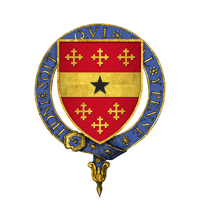John de Beauchamp, 1st Baron Beauchamp de Warwick
| Admiral of the Fleet Sir John de Beauchamp | |
|---|---|
| Born |
1316 Warwick |
| Died |
2 December 1360 City of London |
| Buried | Old St Paul's Cathedral |
| Allegiance |
|
| Service/ |
|
| Years of service | 1338–1360 |
| Rank | Admiral |
| Commands held |
Admiral of the Fleet Admiral of the South Admiral of the West Constable of the Tower Lord Warden of the Cinque Ports Captain |
| Battles/wars |
Battle of Crécy Battle of Sluys |
Admiral of the Fleet [1] Sir John Paveley de Beauchamp, [2] 1st Baron Beauchamp de Warwick KG (c. 1316 – 2 December 1360) was the third son of Guy de Beauchamp, 10th Earl of Warwick, and brother of Thomas de Beauchamp, 11th Earl of Warwick, with whom he became a founder and the tenth Knight of the Order of the Garter in 1348.[3]
Personal
John de Beauchamp was born in Warwick, England sometime between 1307 and 1316 his parents were Guy De Beauchamp, Earl of Warwick, (1272-1315), Warwick, Warwickshire, England) and Alice De Toeni later Countess of Warwick who had seven children including John towards the end of his life he resided in parish of St. Andrew, near Baynard's Castle, City of London, he bequeathed his house to the King who had it converted for use as his great wardrobe, a bachelor he died without issue and his barony expired. His remains were interred, between two pillars, before the image of the Virgin, on the south side of the nave of Old St Paul's Cathedral, where there was a monument to his memory, incorrectly later known as Duke Humphrey's Tomb, because of the mistaken belief that it was the tomb of Humphrey of Lancaster, 1st Duke of Gloucester.[4] The grave and monument were destroyed along with the old cathedral in the Great Fire of London in 1666. A modern monument in the crypt lists Beauchamp as one of the important graves lost.
Early naval career


He attended King Edward III into Flanders in 1338, was in the array at Vironfosse in 1339, and shared the glory of the great naval victory off Sluys in 1340. He carried the Royal Standard at the Battle of Crécy in 1346 and was present at the siege and surrender of Calais, of which town he was appointed captain in 1348 a post he held for two years before his first appointment to a senior command role.
Senior command
In 1350 he was appointed Admiral of the Fleet off Calais also known as the Southern Fleet [5], five years later on 5 March 1355 he was given command of the Western Sea's Fleet a post he held till 1 March 1356 [6]. He was appointed 'Admiral of the King's Southern, Northern and Western Fleets' on the 18 July 1360 [7]. The appointment gave the command of the English navy to one person for the first time, the post would evolve into the post of Admiral of the Fleet [8], he also held the posts of Constable of the Tower of London and Warden of the Cinque Ports. He was summoned to Parliament as a Baron in 1350.[3]
References
- ↑ Houbraken, Jacobus; Thoyras, Paul de Rapin; Vertue, George (1747). The History of England, A List of Admirals of England, 1228-1745. J. and P. Knapton. p. 270.
- ↑ Mangone, Gerard J. (1997). United States Admirality Law. Leiden, Netherlands: Martinus Nijhoff Publishers. p. 9. ISBN 9041104178.
- 1 2 George Frederick Beltz, Memorials of the Most Noble Order of the Garter (1861)
- ↑ W. Carew Hazlitt, Faiths and Folklores, 1905, p.196.
- ↑ Bothwell, James (2004). Edward III and the English Peerage: Royal Patronage, Social Mobility, and Political Control in Fourteenth-century England. Boydell Press. p. 97. ISBN 9781843830474.
- ↑ Bothwell, James (2004). Edward III and the English Peerage: Royal Patronage, Social Mobility, and Political Control in Fourteenth-century England. Boydell Press. p. 97. ISBN 9781843830474.
- ↑ 1, St. George Tucker. Vol. (1996). Blackstone's commentaries : with notes of reference to the constitution and laws, of the federal government of the United States, and of the Commonwealth of Virginia; with an appendix to each volume, containing short tracts upon such subjects as appeared necessary to form a connected view of the laws of Virginia as a member of the federal union (Originally published: Philadelphia : William Young Birch, and Abraham Small, 1803. ed.). Union, NJ: Lawbook Exchange. p. xxxiii. ISBN 9781886363168.
- ↑ "Trafalgar Ancestors, Glossary". nationalarchives.gov.uk. National Archives, 2017. Retrieved 24 July 2017.
Sources
- Archives, National The. (2017). "Trafalgar Ancestors, Glossary". nationalarchives.gov.uk. National Archives. London. England
- Bothwell, James (2004). Edward III and the English Peerage: Royal Patronage, Social Mobility, and Political Control in Fourteenth-century England. Boydell Press. ISBN 9781843830474.
- Houbraken, Jacobus. Thoyras, Paul de Rapin. Vertue, George. (1747). The History of England, A List of Admirals of England (1224-1745). England. Kanpton. P and J.
- Mangone, Gerard J. (1997). United States Admirality Law. Leiden, Netherlands: Martinus Nijhoff Publishers. ISBN 9041104178.